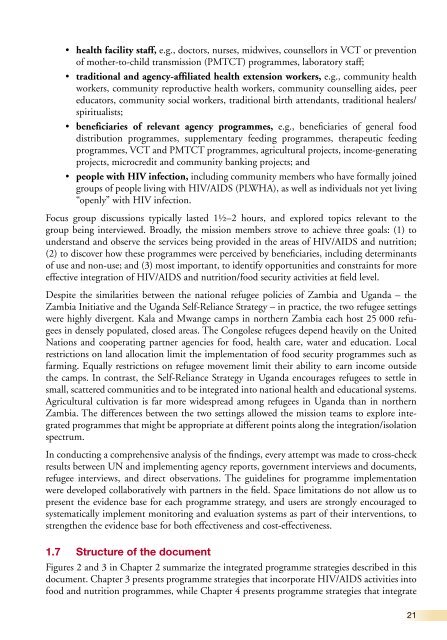Integration of HIV/AIDS activities with food and nutrition support in ...
Integration of HIV/AIDS activities with food and nutrition support in ...
Integration of HIV/AIDS activities with food and nutrition support in ...
Create successful ePaper yourself
Turn your PDF publications into a flip-book with our unique Google optimized e-Paper software.
• health facility staff, e.g., doctors, nurses, midwives, counsellors <strong>in</strong> VCT or prevention<br />
<strong>of</strong> mother-to-child transmission (PMTCT) programmes, laboratory staff;<br />
• traditional <strong>and</strong> agency-affiliated health extension workers, e.g., community health<br />
workers, community reproductive health workers, community counsell<strong>in</strong>g aides, peer<br />
educators, community social workers, traditional birth attendants, traditional healers/<br />
spiritualists;<br />
• beneficiaries <strong>of</strong> relevant agency programmes, e.g., beneficiaries <strong>of</strong> general <strong>food</strong><br />
distribution programmes, supplementary feed<strong>in</strong>g programmes, therapeutic feed<strong>in</strong>g<br />
programmes, VCT <strong>and</strong> PMTCT programmes, agricultural projects, <strong>in</strong>come-generat<strong>in</strong>g<br />
projects, microcredit <strong>and</strong> community bank<strong>in</strong>g projects; <strong>and</strong><br />
• people <strong>with</strong> <strong>HIV</strong> <strong>in</strong>fection, <strong>in</strong>clud<strong>in</strong>g community members who have formally jo<strong>in</strong>ed<br />
groups <strong>of</strong> people liv<strong>in</strong>g <strong>with</strong> <strong>HIV</strong>/<strong>AIDS</strong> (PLWHA), as well as <strong>in</strong>dividuals not yet liv<strong>in</strong>g<br />
“openly” <strong>with</strong> <strong>HIV</strong> <strong>in</strong>fection.<br />
Focus group discussions typically lasted 1½–2 hours, <strong>and</strong> explored topics relevant to the<br />
group be<strong>in</strong>g <strong>in</strong>terviewed. Broadly, the mission members strove to achieve three goals: (1) to<br />
underst<strong>and</strong> <strong>and</strong> observe the services be<strong>in</strong>g provided <strong>in</strong> the areas <strong>of</strong> <strong>HIV</strong>/<strong>AIDS</strong> <strong>and</strong> <strong>nutrition</strong>;<br />
(2) to discover how these programmes were perceived by beneficiaries, <strong>in</strong>clud<strong>in</strong>g determ<strong>in</strong>ants<br />
<strong>of</strong> use <strong>and</strong> non-use; <strong>and</strong> (3) most important, to identify opportunities <strong>and</strong> constra<strong>in</strong>ts for more<br />
effective <strong>in</strong>tegration <strong>of</strong> <strong>HIV</strong>/<strong>AIDS</strong> <strong>and</strong> <strong>nutrition</strong>/<strong>food</strong> security <strong>activities</strong> at field level.<br />
Despite the similarities between the national refugee policies <strong>of</strong> Zambia <strong>and</strong> Ug<strong>and</strong>a – the<br />
Zambia Initiative <strong>and</strong> the Ug<strong>and</strong>a Self-Reliance Strategy – <strong>in</strong> practice, the two refugee sett<strong>in</strong>gs<br />
were highly divergent. Kala <strong>and</strong> Mwange camps <strong>in</strong> northern Zambia each host 25 000 refugees<br />
<strong>in</strong> densely populated, closed areas. The Congolese refugees depend heavily on the United<br />
Nations <strong>and</strong> cooperat<strong>in</strong>g partner agencies for <strong>food</strong>, health care, water <strong>and</strong> education. Local<br />
restrictions on l<strong>and</strong> allocation limit the implementation <strong>of</strong> <strong>food</strong> security programmes such as<br />
farm<strong>in</strong>g. Equally restrictions on refugee movement limit their ability to earn <strong>in</strong>come outside<br />
the camps. In contrast, the Self-Reliance Strategy <strong>in</strong> Ug<strong>and</strong>a encourages refugees to settle <strong>in</strong><br />
small, scattered communities <strong>and</strong> to be <strong>in</strong>tegrated <strong>in</strong>to national health <strong>and</strong> educational systems.<br />
Agricultural cultivation is far more widespread among refugees <strong>in</strong> Ug<strong>and</strong>a than <strong>in</strong> northern<br />
Zambia. The differences between the two sett<strong>in</strong>gs allowed the mission teams to explore <strong>in</strong>tegrated<br />
programmes that might be appropriate at different po<strong>in</strong>ts along the <strong>in</strong>tegration/isolation<br />
spectrum.<br />
In conduct<strong>in</strong>g a comprehensive analysis <strong>of</strong> the f<strong>in</strong>d<strong>in</strong>gs, every attempt was made to cross-check<br />
results between UN <strong>and</strong> implement<strong>in</strong>g agency reports, government <strong>in</strong>terviews <strong>and</strong> documents,<br />
refugee <strong>in</strong>terviews, <strong>and</strong> direct observations. The guidel<strong>in</strong>es for programme implementation<br />
were developed collaboratively <strong>with</strong> partners <strong>in</strong> the field. Space limitations do not allow us to<br />
present the evidence base for each programme strategy, <strong>and</strong> users are strongly encouraged to<br />
systematically implement monitor<strong>in</strong>g <strong>and</strong> evaluation systems as part <strong>of</strong> their <strong>in</strong>terventions, to<br />
strengthen the evidence base for both effectiveness <strong>and</strong> cost-effectiveness.<br />
1.7 Structure <strong>of</strong> the document<br />
Figures 2 <strong>and</strong> 3 <strong>in</strong> Chapter 2 summarize the <strong>in</strong>tegrated programme strategies described <strong>in</strong> this<br />
document. Chapter 3 presents programme strategies that <strong>in</strong>corporate <strong>HIV</strong>/<strong>AIDS</strong> <strong>activities</strong> <strong>in</strong>to<br />
<strong>food</strong> <strong>and</strong> <strong>nutrition</strong> programmes, while Chapter 4 presents programme strategies that <strong>in</strong>tegrate<br />
21

















